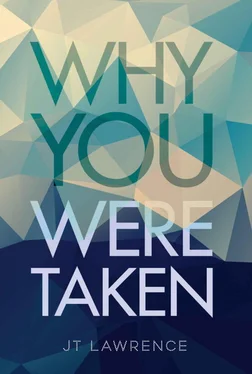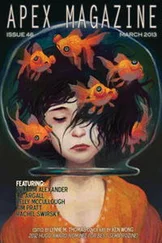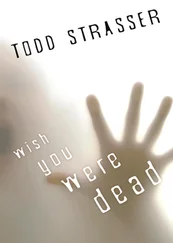Blue, brown, brown, grey, yellow, thinks Kirsten . 49981. It’s the code, she realises: the code to get out.
‘Don’t you see?’ he says again, this time more urgently, pride like fever in his face. ‘We did it! We are responsible for the ultimate bloodless revolution!’
Johannesburg, 2021
Keke stirs on the couch, but settles down again. Van der Heever is tireless.
‘If you put your emotions aside for just a moment and look at the results – morally and ethically speaking, it’s accepted that the welfare of the many should take precedence over the welfare of the few, and as such, sacrifices needed to be made. We were not, contrary to what you may think, barbarous about it, as many eugenicists have been before us… unwitting patients waking up, in pain, only to realise that their uteri had been removed. Our solution was much more humane. Cleaner. In fact, we believe that once it becomes clear what has happened here, other countries will follow suit, and soon we’ll have a global population that is both under control and more efficient.’
‘Next stop: cyborgs,’ says Seth, ‘that’s not a world I want to live in.’
‘Dear boy, if the population of the rest of the world keeps growing as it is, there will no longer be a world to live in. We are safeguarding the future for all.’
‘For some. For those you deem fit. Others you deny a future altogether. How many cells are there?’ asks Kirsten. ‘How many people’s lives have you stolen?’
‘A dozen, maybe more. An infinitesimal portion of the population. Genesis members, however, are in the thousands. They’re in every strata of South African life.’ He lifts his palms to the ceiling, as if he is some kind of prophet. ‘How else would we be able to pull this off?’
‘I still don’t understand,’ says Seth, perhaps trying to buy more time, ‘the point of the clone project. So you isolated some interesting genes. Then what?’
‘You wouldn’t believe me if I told you.’
‘Try me. What was the point? To splice a little army for yourself? Take over the world?’
‘The point was to create a superior race.’
‘So not unlike Hitler, then,’ says Kirsten.
‘To the contrary, dear Kate. It was never about me, never about power. I’ve never liked the limelight. A superior race would get ill less often, work harder, be more intelligent, less violent, have more talents, and lead more fulfilling lives. It was to make the world a better place.’
‘But how would it work,’ asks Seth, ‘in your sad, imaginary world? Deserving parents would get their license and then come along to you for a designer embryo? You harvest their eggs and sperm and make a few little tweaks, remove any genetic abnormalities, add some extra brains or blue eyes. Ask them if they’d prefer a boy or a girl. It’s bespoke IVF. You’re fooling yourself. You’re not making the world a better place. You’re in the designer baby business – a fertility quack – there is nothing new or noble about that.’
‘You don’t understand how far technology has come,’ smiles the doctor.
‘Okay, you straight-out clone them, then.’
‘Cloning is now old tech. It was never very successful. The ratio of live births wasn’t good at all. We started with cloning because it was the best technology we had at the time, but now… now we have other means. Besides, cloning is still dependent on the pregnancy and birth being successful. There are just too many things that can go wrong. Too many variables we can’t control. So… we cut out the gestation period.’
‘Wait,’ says Kirsten, ‘what?’
‘You’ve cut out the gestation?’ says Seth. ‘As in, you grow them in artificial wombs, in the lab?’
Kirsten pictures a room filled with transparent silicone wombs and feels like throwing up again.
‘We experimented with that, but it wasn’t a viable solution in the end. It was difficult to get the exact… nuances of the environment right.’
‘Right,’ says Seth. He was genuinely interested now. You could see his brain working, thinking of possible alternatives. He comes up blank. ‘Okay, now you have to tell me.’
Dr Van der Heever’s lips curl up into a smile, there is a snap in his eyes.
‘We print them,’ he says, not being able to keep the pride out of his voice. ‘We print babies.’
THAT’S WHAT FRANKENSTEIN SAID
38
Johannesburg, 2021
‘You print babies,’ repeats Seth. It’s not sinking in.
‘That’s impossible,’ says Kirsten.
‘Oh believe me,’ Van der Heever says, ‘it is.’
The doctor gets up from his chair and motions for them to follow him. He activates a door hidden in his bookshelf, which swings open, and he steps through. Mouton pushes them forward from behind, leaving Keke on the couch in the den. Soon they are standing in the white cube of a pristine lab (Immaculate Conception), the dirt and blood on their clothes and skin highlighted by the brightness, adding to the surreal quality of the moment.
Kirsten looks down at her hands, fingernails black with grime, but is distracted by a small cry in the corner. She studies the row of incubators against the wall: a stack of empty Tupperwares. Did she imagine the sound? Is she imagining this whole thing? She wonders if she is lying unconscious somewhere, at the scene of the earlier car accident, or in hospital, having this bizarre dream.
A nearby machine, monochrome, spins. It looks like some kind of body scanner.
‘We were already printing fully functional organs in 2010. It was the natural progression to print a whole body. All you really need is good software and some DNA. And stem cells, obviously, which there’s no shortage of in our game. We’ve printed over a thousand healthy babies, and we have a 100% success rate. No more failed fertility treatments. No more mothers dying in labour, no more birth injuries or foetal abnormalities. Just screaming healthy newborns with 10 out of 10 Apgars, every time.’
‘But you can’t print a beating heart,’ says Kirsten.
‘Ah, that was one of the most challenging parts,’ says Van der Heever, touching his chest where his own pacemaker is, ‘but a quick current to those heart cells and off they go – galloping along. It’s a beautiful thing to behold.’
Seth: ‘I think that’s what Frankenstein said.’
The doctor indulges Seth with a smile.
‘Where are they, then? The babies?’ asks Kirsten.
‘A lot of them have been adopted out. As you know, the demand for healthy babies nowadays is astronomical.’
‘You sold them?’
‘In a manner of speaking.’
‘So you cause a nation-wide fertility crisis and then set up a designer baby factory,’ says Seth. ‘Genius.’
‘What about the rest?’ asks Kirsten.
‘We evacuated them when we got confirmation that you were coming in.’
‘You evacuated the whole building,’ says Kirsten. The doctor nods, says: ‘I couldn’t take the chance you’d not… co-operate with us.’
‘I wouldn’t ‘co-operate’ with you if my life depended on it.’
‘That’s what I thought you’d say.’
There is another soft sound from the corner: a cooing. Transparent bubbles float playfully towards her. Kirsten blinks forcefully to wipe them out of her vision.
‘That’s why,’ says Van der Heever, ‘I had to up the stakes.’
He walks to the corner incubator, opens the top, and gently lifts a newborn out from inside. He carries the baby back to them like a proud relative. It’s swaddled in a blanket embellished with planes and clouds that float in the sky. The baby squirms, tries to break free, shouts, then fixes Kirsten with an intense stare. She knows she should feel revulsion. The doctor can barely contain his excitement. He raises the baby up, like a trophy, like the prize he’ll never get from his peers.
Читать дальше






![Питер Джеймс - Wish You Were Dead [story]](/books/430350/piter-dzhejms-wish-you-were-dead-story-thumb.webp)




